Vuleads Alternatives
Find your next lead generation tool. This article reviews 10 Vuleads alternatives, breaking down their capabilities and costs for an informed choice.
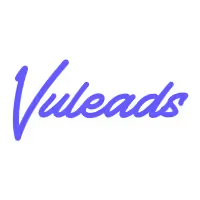
Vuleads is a popular tool for a reason. It excels at creating personalized videos at scale, making it a strong choice for outreach campaigns. When you need a high volume of custom videos, it performs well.
However, some users note limitations, like occasional rendering delays or a desire for more integrations. We've analyzed the best alternatives to Vuleads, using G2 reviews to help you shortlist your choices for a deeper review. Let's get started.
Explore 11x for Digital Sales Workers
If your sales process could benefit from digital workers, consider exploring 11x. The platform provides autonomous agents designed to handle specific sales tasks. This approach can supplement your existing team's efforts and manage repetitive activities.
11x is an all-in-one GTM platform where AI agents manage the sales process. Its agent, Alice, finds prospects, runs outreach on email and LinkedIn, and keeps your CRM updated. Another agent, Julian, qualifies inbound leads and books meetings.
The platform unifies tools for data enrichment, outreach, and email warmup, removing the need for separate point solutions.
Vuleads Alternatives
Here is a detailed breakdown of each Vuleads alternative. We analyze pricing, main features, and the advantages and drawbacks of each option.
1) LinkedIn Sales Navigator
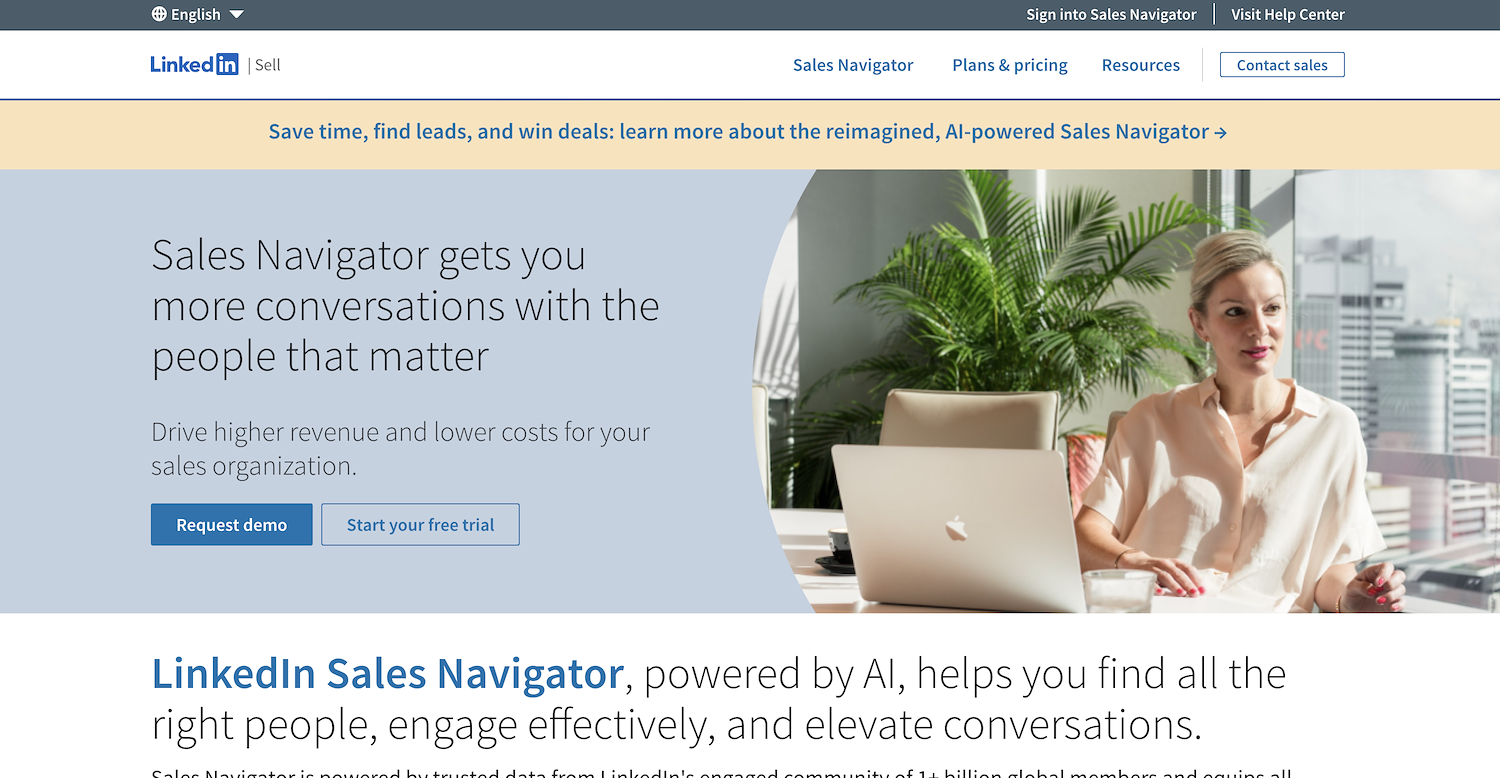
LinkedIn Sales Navigator is a sales intelligence tool on the LinkedIn platform. It equips sales teams with advanced search capabilities to identify relevant leads and accounts. The tool provides insights to help users understand potential buyers.
While it does not create videos, it helps build the target lists for personalized outreach campaigns.
LinkedIn Sales Navigator's Main Features
Offers advanced search capabilities to find relevant leads and accounts.
Provides sales insights to help understand potential buyers.
Builds target lists for personalized outreach campaigns.
LinkedIn Sales Navigator vs. Vuleads: Key Differences
Average Review score: 4.3/5 stars based on 1,990 G2 reviews.
LinkedIn Sales Navigator taps into a network of over 860 million professionals. This provides a vast pool for lead generation, unlike Vuleads, which works with your existing contact lists.
The tool's advanced search filters help you find very specific leads and accounts. This level of data segmentation is more detailed compared to the contact import features in Vuleads.
You receive timely insights about your prospects, such as job changes. This feature gives you relevant reasons to connect, which is a different function from Vuleads' video personalization.
Its integration with CRM tools keeps your sales data synchronized. This is a slightly different focus from Vuleads, which centers on the placement of videos in outreach platforms.
Where LinkedIn Sales Navigator Falls Short
LinkedIn Sales Navigator lacks any video creation capabilities. In contrast, Vuleads is built specifically to produce personalized videos at scale for outreach campaigns.
The tool does not support creative asset generation for campaigns. This is different from Vuleads, which allows you to embed custom videos directly into your outreach sequences.
Its engagement options are mostly confined to the LinkedIn platform. Vuleads provides a versatile video asset that works across various channels, including email and social media.
Pricing and Budget Considerations
LinkedIn Sales Navigator does not list public pricing, and its cost is a frequently cited drawback in user reviews. For specific pricing details based on your team's needs, you will need to contact their sales department through the official website.
2) Apollo.io
Apollo.io is a sales intelligence and engagement platform. It gives sales teams access to a large database of B2B contacts and companies. The platform combines data with tools to engage prospects directly.
Apollo.io's Main Features
Access to a database with over 275 million contacts.
Tools for email and call sequencing to automate outreach.
Lead scoring to prioritize prospects based on engagement.
Analytics to track the performance of outreach campaigns.
Apollo.io vs. Vuleads: Key Differences
Average Review score: 4.8/5 stars based on over 8,000 G2 reviews.
Apollo provides a searchable database of contacts and companies. Vuleads, in contrast, requires you to import your own contact lists for video campaigns.
The platform offers multi-channel outreach automation, including emails and calls. Vuleads focuses on the creation of personalized video assets for use in other outreach tools.
Apollo includes data enrichment features to keep contact information current. Vuleads does not function as a data provider; its purpose is content generation.
Its analytics cover the full outreach sequence performance. Vuleads provides metrics specific to video views and engagement, not the entire campaign funnel.
Where Apollo.io Falls Short
Apollo.io does not have a native function to create personalized videos. This is the core feature of Vuleads, which specializes in video generation at scale.
The platform's wide range of features can introduce a learning curve for new users. Vuleads has a more focused, and potentially simpler, function for teams to adopt.
Some users report occasional inaccuracies in the contact data. This is a common issue for large databases and may require manual verification before outreach.
Pricing and Budget Considerations
Apollo.io offers several pricing tiers, including a free plan for individuals. Paid plans scale based on feature access and usage credits. For current details, you should review the plans on the official pricing page.
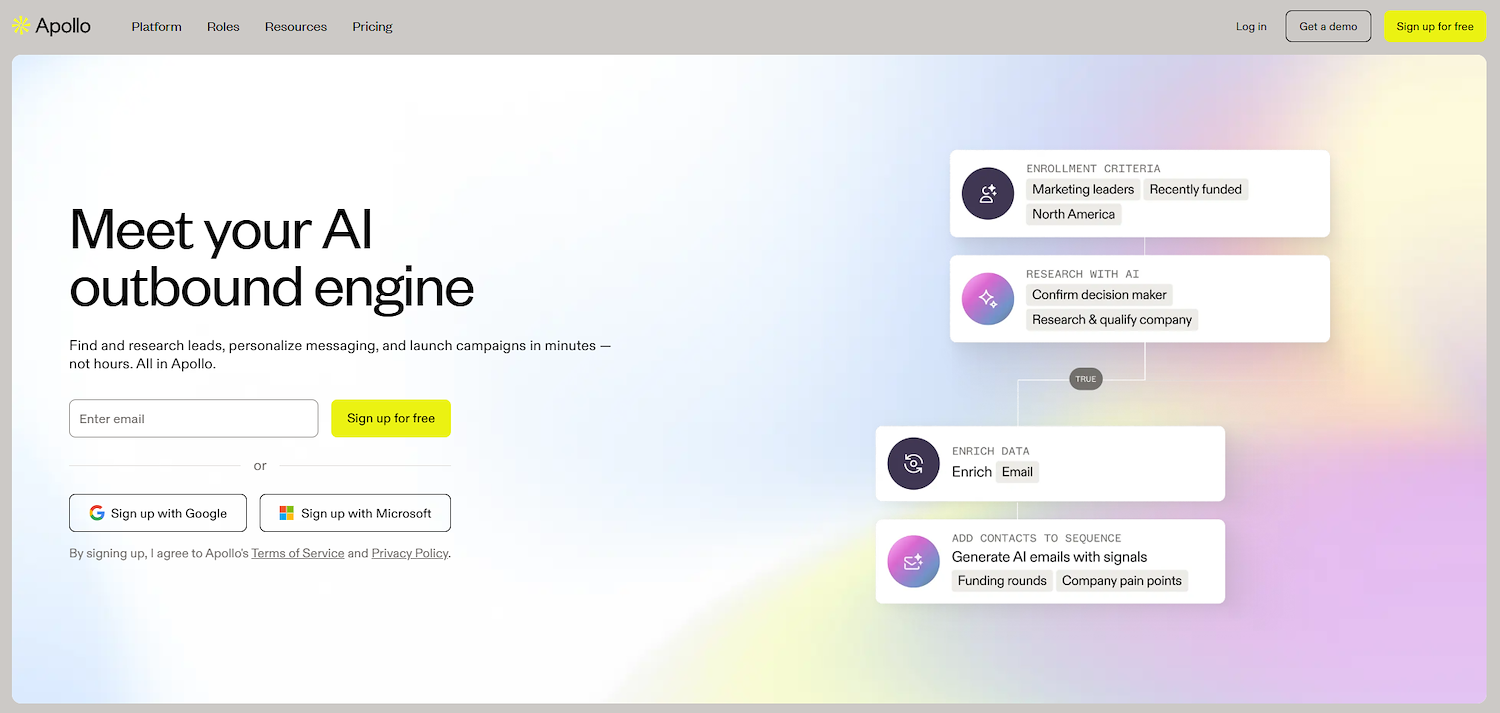
Apollo.io is a sales intelligence and engagement platform. It provides a database of over 275 million contacts and tools for outreach. Teams can use automated email and call sequences, score leads to set priorities, and analyze campaign performance through its analytics functions.
Apollo.io's Main Features
Provides access to a database of over 275 million contacts.
Includes tools for email and call sequencing to automate outreach.
Scores leads to prioritize prospects based on their engagement.
Offers analytics to track the performance of outreach campaigns.
Apollo.io vs. Vuleads: Key Differences
Average Review score: 4.7/5 stars based on 8,904 G2 reviews.
Apollo.io provides a searchable database with over 210 million contacts. In contrast, Vuleads requires you to import your own contact lists for video campaigns.
The platform includes tools for email and call sequencing to automate outreach directly. Vuleads focuses on creating video assets for use in separate outreach platforms.
It offers lead scoring to help prioritize prospects based on their engagement. Vuleads provides metrics specific to video interaction, not the overall lead qualification process.
This tool unifies data, outreach, and analytics in a single platform. This is different from Vuleads, which serves as a specialized tool for personalized video generation.
Where Apollo.io Falls Short Compared to Vuleads
Apollo.io does not have a native function for personalized video creation. This is a significant difference from Vuleads, which is a specialized tool designed specifically for producing custom videos at scale.
Its all-in-one platform includes many features, which can create a learning curve for some users. Vuleads, by contrast, has a more specialized purpose that may be faster for teams to implement for video campaigns.
Some users report occasional inaccuracies within the contact data. This might require manual verification before outreach, unlike Vuleads, which operates using a company's own pre-vetted contact lists.
Pricing and Budget Considerations
Apollo.io provides transparent pricing with a free tier and paid plans starting at $49 per user monthly. Since Vuleads does not publish its pricing, a direct numerical comparison is not possible, but Apollo.io's model offers more predictability for budgeting. For current details, visit Apollo.io's official website.
3) Lusha
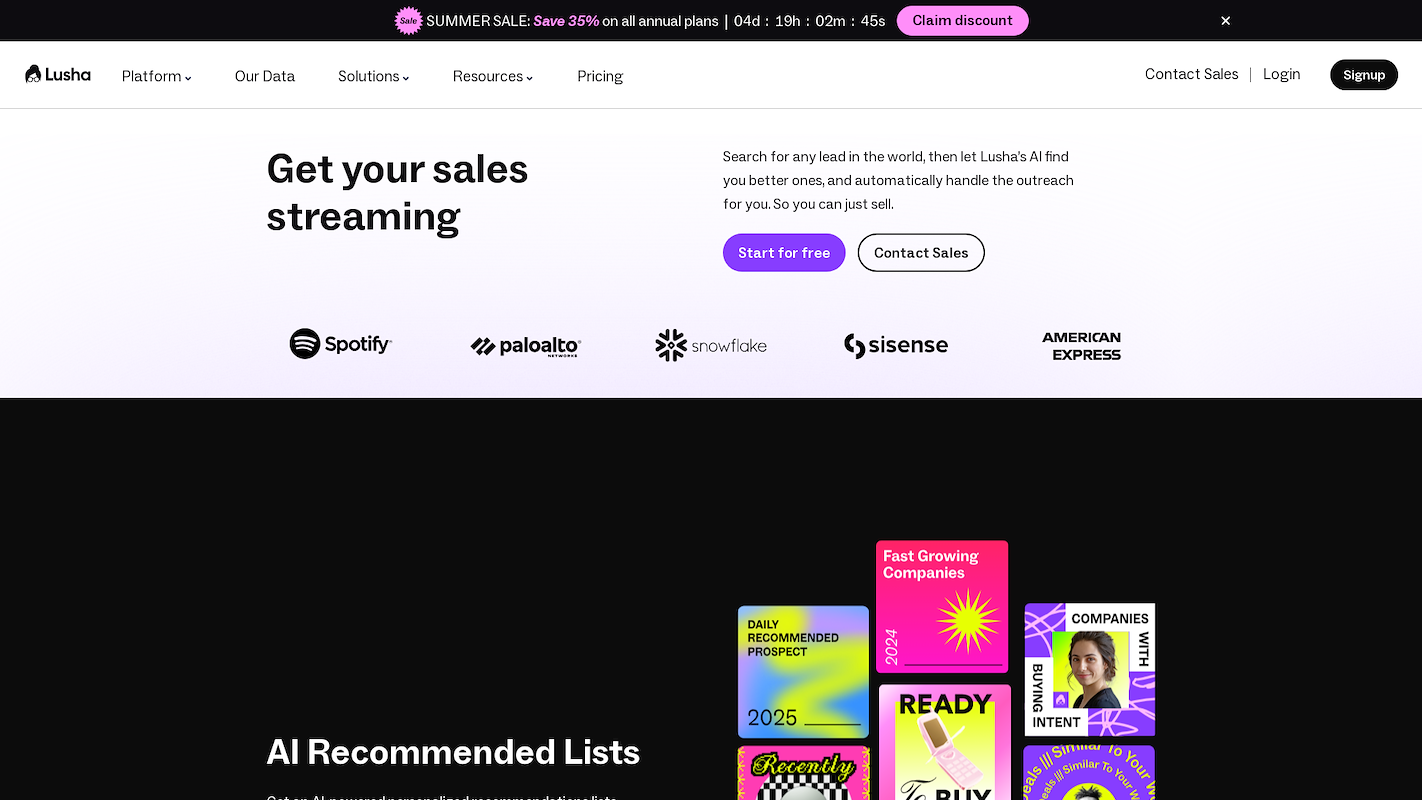
Lusha is a sales intelligence platform for revenue teams to find B2B leads. It uses AI to recommend prospects and automates multichannel outreach. Users can build prospecting lists, prioritize outreach with buyer-intent signals, and receive continuous streams of new, ICP-matched leads.
The platform emphasizes global data coverage and compliance with GDPR and CCPA. It enriches CRM records and integrates with popular sales tools to support existing workflows.
Lusha's Main Features
Creates live, auto-updating lead lists that continuously add fresh prospects at user-defined intervals.
Offers an advanced, AI-powered search with filters for buyer intent and funding rounds.
Identifies in-market buyers and sends real-time notifications based on intent triggers.
Automates and personalizes email sequences using AI-generated copy.
Lusha vs. Vuleads: Key Differences
Average Review score: 4.3/5 stars based on 1,516 G2 reviews.
Lusha provides a large B2B contact database to build new lead lists. This is different from Vuleads, which requires you to import your own contacts for video campaigns.
The platform uses AI to automatically create and refresh prospect lists. This automates the list-building stage, while Vuleads focuses on creating content for lists you have already prepared.
It offers buyer intent data to help you identify prospects actively looking for solutions. This data intelligence feature is distinct from Vuleads, which provides video engagement metrics instead.
This tool enriches your existing CRM records with current contact data. Vuleads, by comparison, is a content generation tool and does not perform data management functions.
Where Lusha Falls Short Compared to Vuleads
Lusha does not include a native video creation tool. This is different from Vuleads, which specializes in producing personalized videos at scale for outreach campaigns.
It focuses on providing contact data and intent signals. In contrast, Vuleads generates creative video assets that you can embed directly into emails to make outreach more personal.
The platform's analytics track general outreach performance. This differs from Vuleads, which offers specific metrics on video engagement, such as view rates and watch time, to measure content impact.
Pricing and Budget Considerations
Lusha offers transparent pricing with a free plan and paid tiers starting at $36 per user, per month. In contrast, Vuleads does not publish its pricing, which means Lusha provides more predictable budgeting. For detailed information, visit Lusha's official website.
4) Hunter.io

Hunter.io is a platform that finds and verifies professional email addresses. Sales teams use it to build contact lists for outreach. The tool can find emails from a specific company domain or locate the address for an individual professional.
An email verifier also checks the deliverability of addresses. This process helps ensure the accuracy of contact lists before a campaign launch.
Hunter.io's Main Features
Finds professional email addresses by searching a specific company domain or by using a person's name and company.
Includes an email verifier that checks addresses in bulk or in real-time to reduce bounce rates and protect sender reputation.
Provides a campaign tool to compose, personalize, schedule automated follow-ups, and track performance.
Offers a browser extension for Chrome, Edge, and Firefox to discover emails while browsing websites.
Hunter.io vs. Vuleads: Key Differences
Average Review score: 4.4/5 stars based on 592 G2 reviews.
Hunter.io finds and verifies professional email addresses, providing the contact data for outreach campaigns. This is different from Vuleads, which creates video content for lists you already have.
The tool provides its own database of professional email addresses found on the web. In contrast, Vuleads requires users to import their own contact lists to create video campaigns.
It includes an email verifier to check the deliverability of addresses, which helps protect sender reputation. Vuleads does not offer a data verification feature, as its focus is on video content creation.
This platform includes a built-in campaign tool for sending and tracking cold emails. This is a different approach from Vuleads, which generates video assets for use within separate outreach platforms.
Where Hunter.io Falls Short Compared to Vuleads
Hunter.io does not have a native function for personalized video creation. This is a significant difference from Vuleads, which is a specialized tool designed for producing custom videos at scale.
The tool focuses on providing contact data and does not generate creative assets. In contrast, Vuleads allows you to embed custom videos directly into emails to make outreach more personal.
Its analytics track general outreach performance. This differs from Vuleads, which offers specific metrics on video engagement, such as view rates and watch time, to measure content impact.
Pricing and Budget Considerations
Hunter.io offers transparent pricing with a free plan and paid tiers starting at $49 per month. This provides more budget predictability than Vuleads, which does not publish its pricing. For current details, visit the official website.
5) ZoomInfo SalesOS
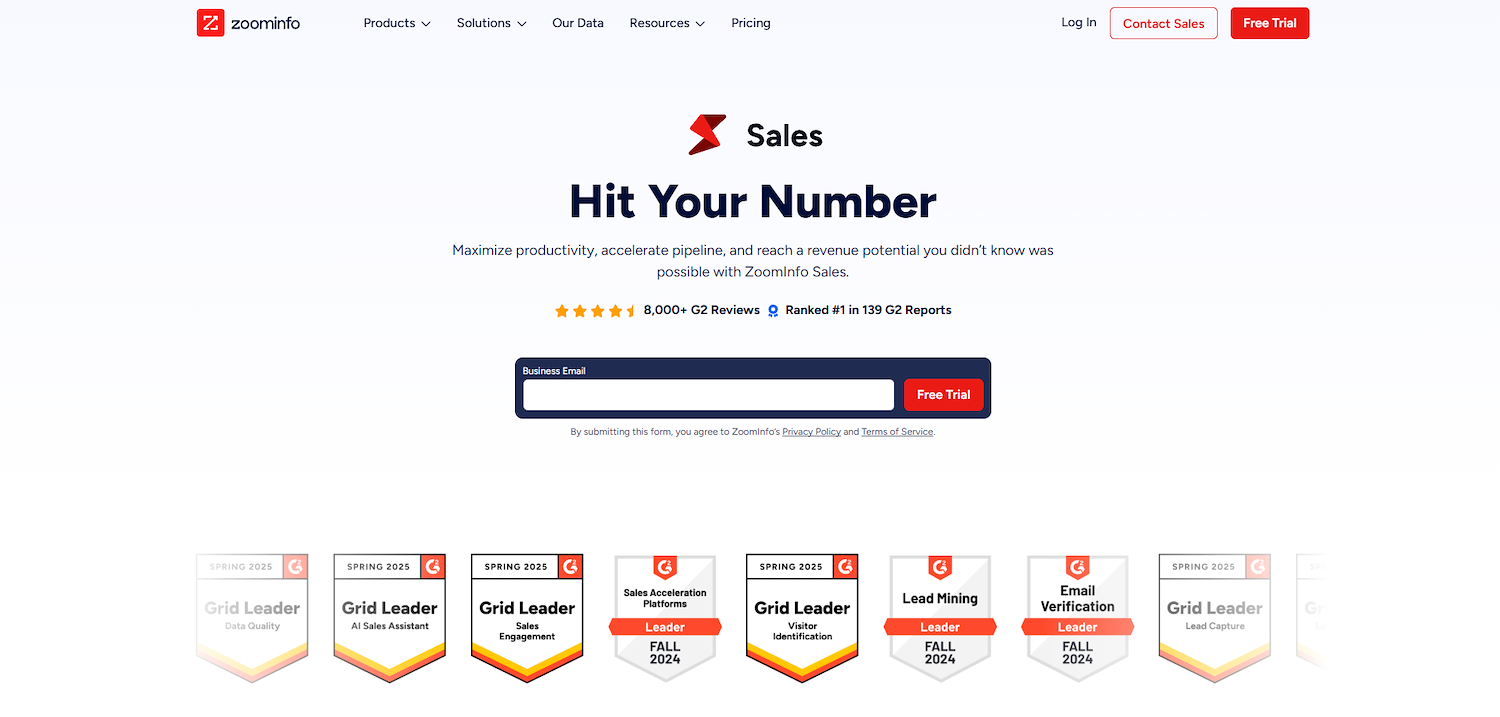
ZoomInfo SalesOS is a go-to-market platform for B2B companies. It provides the data, intelligence, and technology that revenue teams use to reach their goals. With the platform, sales teams can identify ideal customers and connect with them to build a pipeline.
The system helps find buyers ready to purchase, close more deals, and expand business with current customers. It is designed to give revenue teams the information they need to find and win business.
ZoomInfo SalesOS's Main Features
Provides access to a database with over 70 million direct-dial phone numbers and 174 million verified email addresses.
Tracks companies researching solutions like yours to engage them at the earliest stage of the buyer’s journey.
Identifies anonymous site visitors and surfaces the decision-makers behind the clicks.
Analyzes calls, meetings, and emails to understand deal drivers and refine sales processes.
ZoomInfo SalesOS vs. Vuleads: Key Differences
Average Review score: 4.5/5 stars based on 8,738 G2 reviews.
ZoomInfo SalesOS offers a large database of company and contact insights. This is different from Vuleads, which works with the contact lists you already have.
The platform tracks companies that research solutions like yours. This provides early buyer signals, a feature not present in Vuleads, which focuses on video engagement metrics.
This tool identifies anonymous visitors to your website and shows you the decision-makers. Vuleads, in contrast, generates video content and does not have a visitor identification function.
Its AI Copilot gives recommendations on who to contact and what to say. This is a different approach from Vuleads, which creates the video asset but does not guide the outreach strategy.
Where ZoomInfo SalesOS Falls Short
ZoomInfo SalesOS does not generate personalized video content. Teams that want to add video to their outreach must use a separate, specialized tool like Vuleads for that function.
The platform's features center on data-driven outreach recommendations. It does not create dynamic, visual content like personalized videos, which is the core function of Vuleads.
Its analytics do not provide insights into video performance. Unlike Vuleads, it cannot track metrics like video watch time or click-through rates, which help measure content effectiveness.
Pricing and Budget Considerations
Neither ZoomInfo SalesOS nor Vuleads publishes pricing, making a direct comparison difficult. For accurate cost information based on your needs, you must contact the sales team through the ZoomInfo SalesOS's official website.
Consider 11x for Sales Automation
If your goal is to automate sales tasks with digital workers, 11x is a platform to evaluate. Its autonomous agents handle activities from prospect discovery to lead qualification. This can free up your sales team to focus on high-value conversations. Explore 11x for your GTM strategy.
At 11x, our AI agents manage your sales playbook. Alice finds accounts, enriches data, and handles outreach. Julian takes calls, qualifies leads, and schedules meetings. We unify tools for intent signals and email warmup, so you don't need separate point solutions.
Book a demo to see it in action.
6) Seamless.AI
Seamless.AI is a sales intelligence platform that helps users find verified B2B contact information. It provides a database of emails and direct dials that sales teams use to build targeted lead lists for outreach.
Seamless.AI's Main Features
Provides a real-time search engine to find verified cell phones, emails, and direct dials.
Includes data enrichment to clean and update contact information within a CRM.
Offers buyer intent data to identify companies actively searching for solutions.
Uses AI to recommend contacts and companies that match an ideal customer profile.
Seamless.AI vs. Vuleads: Key Differences
Average Review score: 4.2/5 stars based on 1,581 G2 reviews.
Seamless.AI provides a database of B2B contacts to build new lead lists. This is different from Vuleads, which requires you to import your own contacts for video campaigns.
The platform's real-time search engine finds contact information on demand. Vuleads, in contrast, is a content generation tool and does not function as a data provider.
It offers buyer intent data to help identify prospects actively looking for solutions. This data intelligence feature is distinct from Vuleads, which provides video engagement metrics instead.
This tool enriches your existing CRM records with current contact data. Vuleads, by comparison, is a content generation tool and does not perform data management functions.
Where Seamless.AI Falls Short Compared to Vuleads
Seamless.AI does not have a native function for personalized video creation. This is a significant difference from Vuleads, which is a specialized tool designed for producing custom videos at scale.
The tool focuses on providing contact data and does not generate creative assets. In contrast, Vuleads allows you to embed custom videos directly into emails to make outreach more personal.
Its analytics do not provide insights into video performance. Unlike Vuleads, it cannot track metrics like video watch time or click-through rates, which help measure content effectiveness.
Pricing and Budget Considerations
Seamless.AI offers a free plan with limited credits. Paid plans are customized based on team size and needs, requiring you to contact their sales department for a quote. For more information, visit the official pricing page.
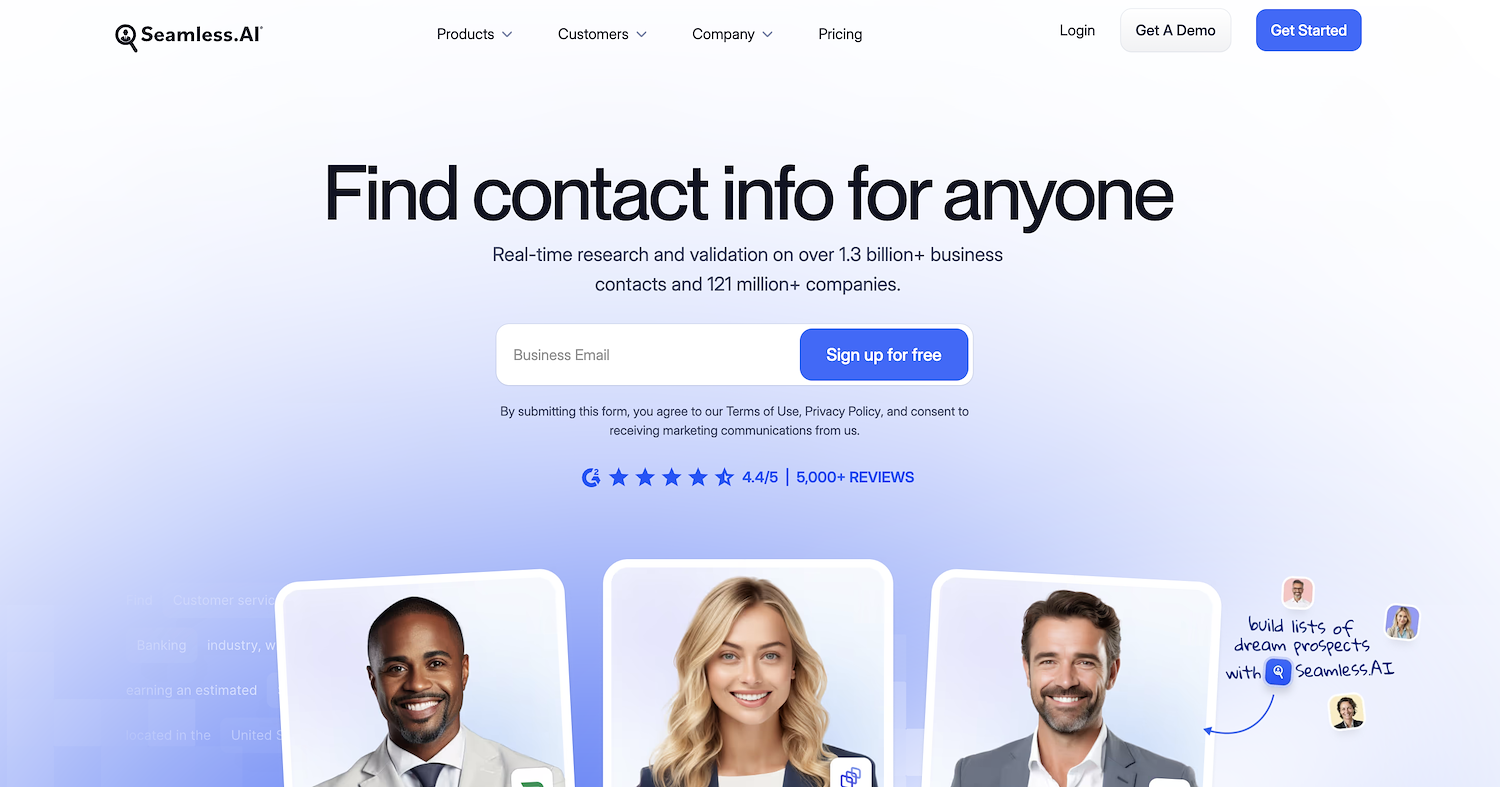
Seamless.AI is a sales intelligence platform with a real-time search engine for verified B2B contact information. It provides emails and direct dials for outreach lists. The tool also offers buyer intent data to identify active companies and uses AI to recommend contacts that match a customer profile.
Seamless.AI's Main Features
Researches and verifies contact information in real-time using an AI-powered search engine.
Identifies prospects ready to buy through buyer intent data signals.
Enriches CRM data in bulk by turning a single data point like an email or domain into a full record.
Generates research and personalized pitch intelligence using AI.
Seamless.AI vs. Vuleads: Key Differences
Average Review score: 4.4/5 stars based on 5,067 G2 reviews.
Seamless.AI provides a database of over 1.7 billion contacts to build new lead lists. This is different from Vuleads, which requires you to import your own contacts for video campaigns.
It offers buyer intent data to identify companies actively searching for solutions. This data intelligence feature is distinct from Vuleads, which provides video engagement metrics instead.
The platform's real-time search engine finds and verifies contact information on demand. In contrast, Vuleads is a content generation tool and does not function as a data provider.
This tool enriches existing CRM records with current contact data. Vuleads, by comparison, is a content generation tool and does not perform data management functions.
Where Seamless.AI Falls Short Compared to Vuleads
Seamless.AI focuses on the delivery of contact data and does not have a feature to create visual, personalized content. In contrast, Vuleads is built to produce custom videos that can make an outreach message stand out in a crowded inbox.
The platform helps users build lists but does not offer tools to increase engagement through dynamic media. Vuleads, however, provides a way to embed personalized videos directly into emails, which can improve how prospects interact with the message.
Its analytics measure campaign outreach but lack metrics for video engagement. This is different from Vuleads, which tracks view duration and click-throughs to help teams understand how their video content performs and refine their approach.
Pricing and Budget Considerations
Seamless.AI offers a free plan, but its paid tiers are customized and require a sales quote. Since Vuleads also does not publish its pricing, a direct comparison is not possible. For a quote based on your needs, you must contact sales via the Seamless.AI official website.
7) LeadIQ
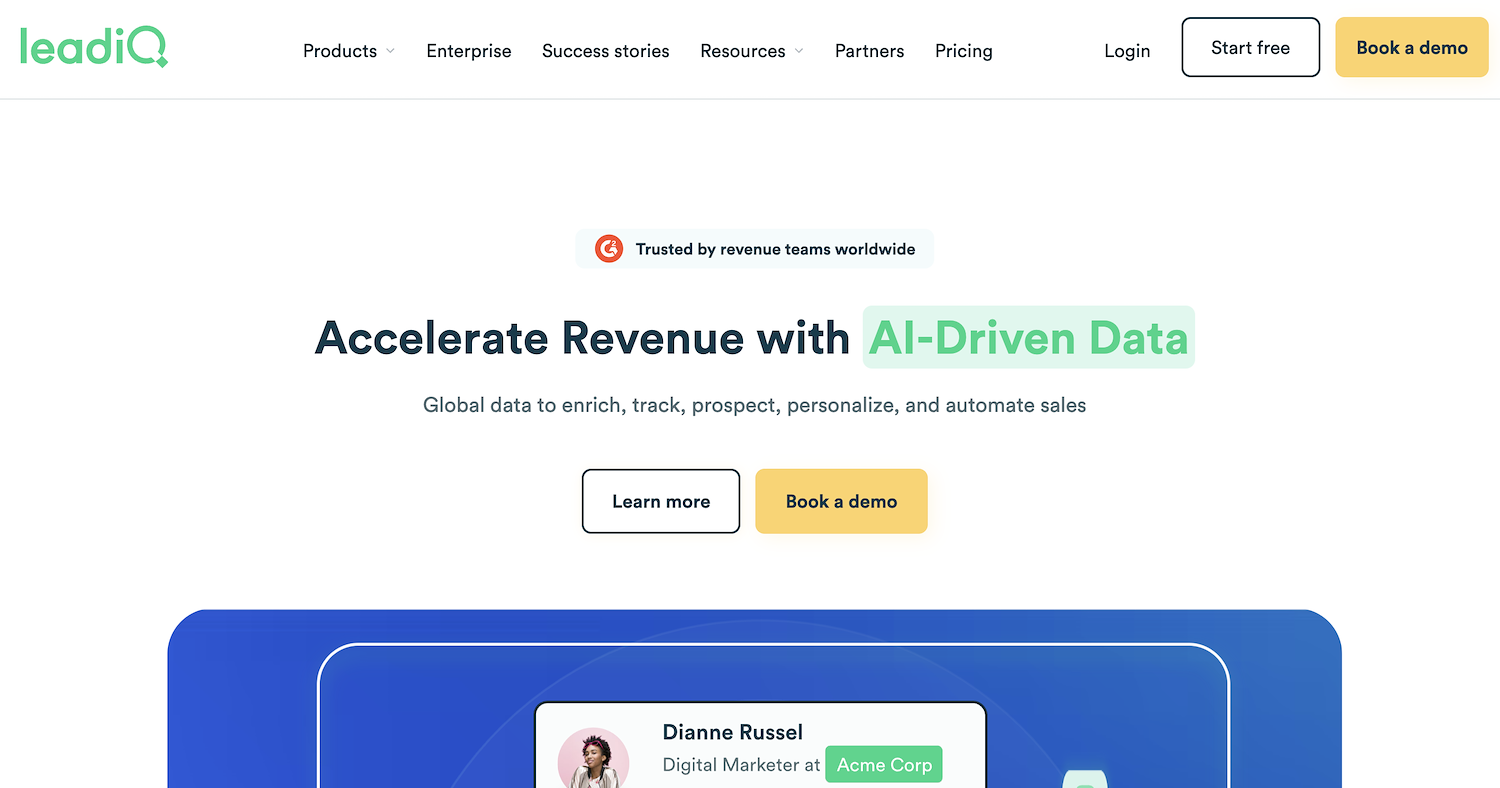
LeadIQ is a prospecting platform that helps sales teams build lead lists with verified contact data. The tool finds work emails and mobile numbers for contacts within target accounts. It also tracks job changes and other trigger events to signal outreach opportunities. Sales teams use this information to connect with decision-makers and support outbound campaigns with timely communication.
LeadIQ's Main Features
Generates personalized outreach messages using an AI tool called Scribe.
Tracks job changes and promotions to provide timely outreach signals.
Captures contact data from LinkedIn with one click and syncs it to Salesforce, HubSpot, and other engagement tools.
Enriches CRM records in bulk with customizable field mapping.
LeadIQ vs. Vuleads: Key Differences
Average Review score: 4.2/5 stars based on 1,097 G2 reviews.
LeadIQ provides a database to find prospect data. This is different from Vuleads, which requires you to import your own contact lists for video campaigns.
The platform includes an AI tool called Scribe to generate personalized text for outreach. In contrast, Vuleads focuses on creating personalized video content.
It tracks sales triggers like job changes to signal timely outreach opportunities. Vuleads, on the other hand, provides metrics on video engagement rather than external prospect activities.
This tool captures contact data directly from LinkedIn with a browser extension. Vuleads does not offer a data capture function, as it works with pre-existing lists.
Where LeadIQ Falls Short Compared to Vuleads
LeadIQ lacks a native video creation function. In contrast, Vuleads is a specialized platform that produces custom videos at scale, which can make outreach messages stand out in an inbox.
The tool provides contact data and text suggestions for outreach. This is different from Vuleads, which generates a dynamic video asset to embed in emails for a more personal connection.
Its analytics do not offer insights into video performance. Unlike Vuleads, it cannot track metrics like watch time or click-through rates, which help measure how visual content performs.
Pricing and Budget Considerations
LeadIQ offers transparent pricing with a free plan and paid tiers starting at $45 per user, per month. Since Vuleads does not publish its pricing, LeadIQ provides more predictable budgeting. For detailed information, visit the official website.
8) Snov.io

Snov.io is a sales automation platform for cold outreach. It provides tools to find leads, verify email addresses, and send automated email campaigns. Sales teams use the platform to manage the outreach process, from prospect discovery to contact and follow-up sequences.
Snov.io's Main Features
Offers sales force and marketing automation, along with task and activity management.
Manages contacts, accounts, and leads, as well as the opportunity and sales pipeline.
Provides contact, company, and industry research data.
Includes reporting and analytics capabilities with dashboards.
Snov.io vs. Vuleads: Key Differences
Average Review score: 4.6/5 stars based on 450 G2 reviews.
Snov.io provides contact and company data, which allows you to build new lead lists. In comparison, Vuleads requires you to import your own contact lists for video campaigns.
The platform includes sales and marketing automation to manage outreach campaigns in one place. This differs from Vuleads, which is a specialized tool for creating video content for use in other platforms.
This tool helps you manage your sales pipeline and track opportunities. Vuleads does not have a pipeline management function, as its purpose is to generate video content for outreach.
Its reporting and analytics cover the full sales process. This offers a broader performance overview than Vuleads, which provides metrics focused only on video engagement.
Where Snov.io Falls Short Compared to Vuleads
Snov.io does not produce personalized video content for outreach. This is a core difference from Vuleads, which is built specifically to generate custom videos that can increase prospect engagement.
The platform's engagement tools are limited to text-based campaigns. It lacks the ability to create and embed dynamic video assets, a feature central to Vuleads that makes messages more personal.
Its analytics measure the performance of email campaigns but do not track video-specific metrics. This is unlike Vuleads, which provides data on view rates and watch time to help teams assess video impact.
Pricing and Budget Considerations
Snov.io offers a free trial and several paid plans, with the Starter tier at $39 per month. This provides more budget predictability than Vuleads, which does not publish its pricing. For current details, visit the official website.
Pricing and Budget Considerations
Snov.io offers transparent pricing with a free trial and paid plans starting at $39 per month. This provides more budget predictability than Vuleads, which does not publish its pricing. For current details, visit the official website.
9) RocketReach
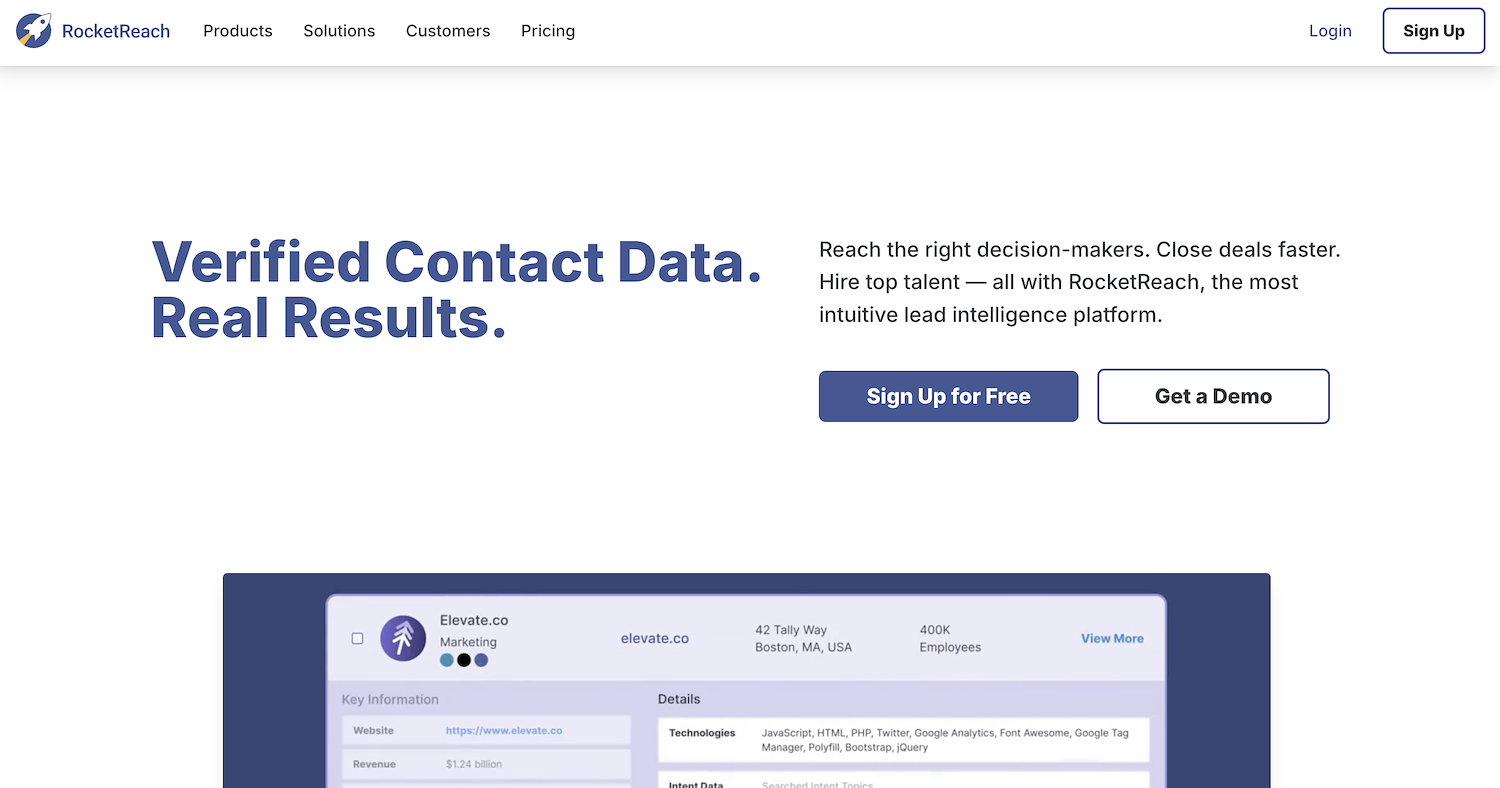
RocketReach is a platform to find contact information for professionals. It provides access to a large database of emails and phone numbers. Sales teams use this data to build prospect lists for their outreach efforts. For teams that use personalized video, the tool helps source the contacts needed to run a campaign at scale.
RocketReach's Main Features
Provides access to a database of over 700 million professionals and 35 million companies worldwide.
Offers advanced search capabilities and data filtering to build targeted contact lists.
Includes browser extensions for Chrome and Edge, bulk lookup features, and an API for integrations.
Cleans and enriches existing data to maintain the accuracy of contact information.
RocketReach vs. Vuleads: Key Differences
Average Review score: 4.4/5 stars based on 918 G2 reviews.
RocketReach provides a database of over 700 million professionals to build new lead lists. This is different from Vuleads, which requires you to import your own contacts for video campaigns.
The platform offers data enrichment to clean and update contact information. Vuleads, in contrast, is a content generation tool and does not perform data management functions.
It includes advanced search filters to build targeted contact lists. This data segmentation capability is a different function compared to Vuleads, which personalizes content for lists you already have.
This tool offers an API and bulk lookup features for data integration. Vuleads focuses on embedding video assets into outreach platforms, not on large-scale data transfer.
Where RocketReach Falls Short Compared to Vuleads
RocketReach does not generate personalized video content. Teams that want to add video to their outreach must use a separate, specialized tool like Vuleads for that function.
The platform's features center on data-driven outreach. It does not create dynamic, visual content like personalized videos, which is the core function of Vuleads.
Its analytics do not provide insights into video performance. Unlike Vuleads, it cannot track metrics like video watch time or click-through rates, which help measure content effectiveness.
Pricing and Budget Considerations
RocketReach offers transparent pricing with a free plan and paid tiers starting at $99 per month. Since Vuleads does not publish its pricing, RocketReach provides more predictable budgeting. For current details, visit the RocketReach's official website.
10) Clearbit
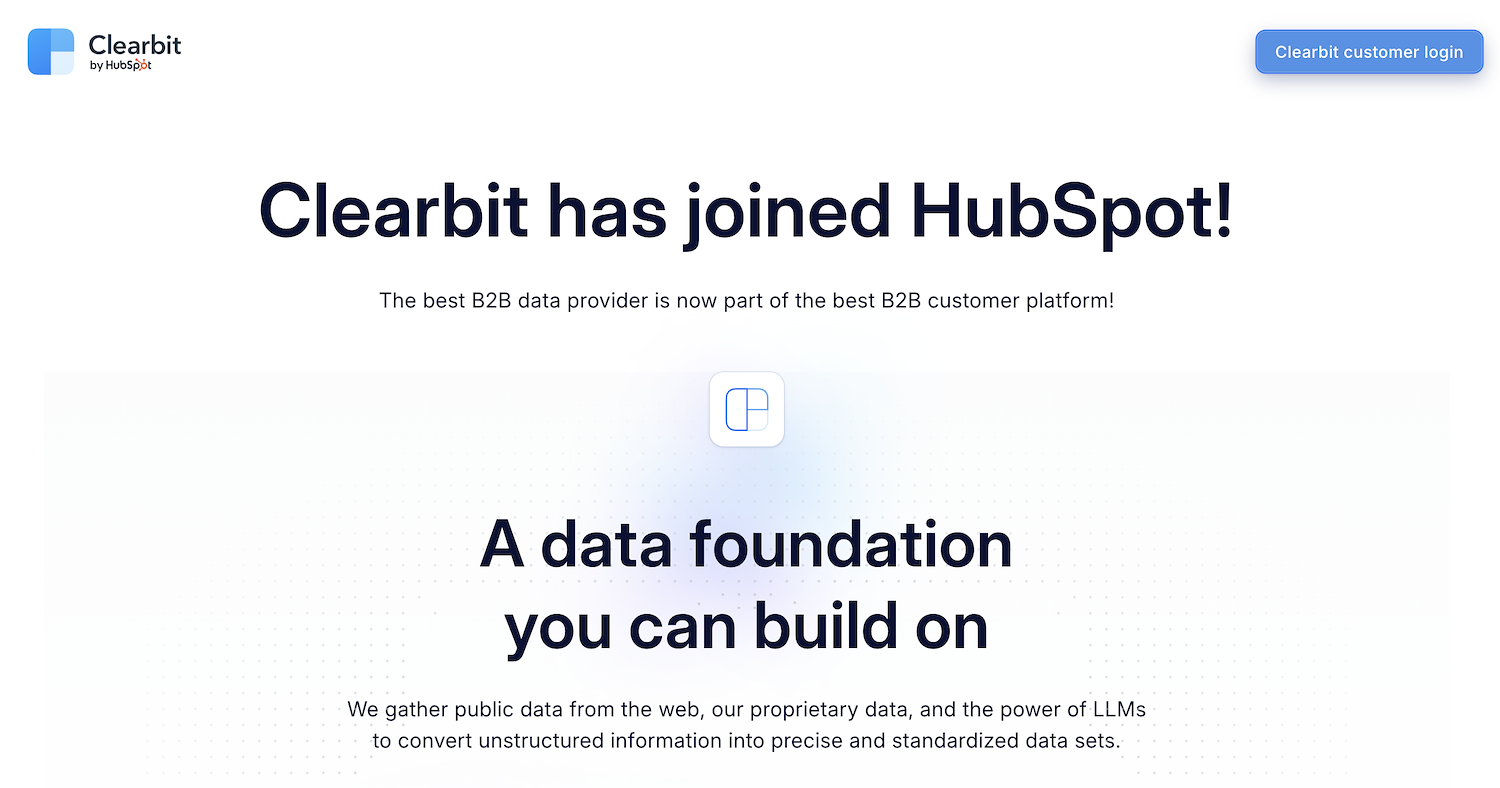
Clearbit is a marketing data platform for B2B teams. It provides data to help companies understand customers, identify prospects, and personalize marketing and sales interactions. The platform enriches records with company and contact information.
This data supports targeted outreach and helps create relevant customer experiences. It integrates with existing tools to power go-to-market strategies with current, correct data.
Clearbit's Main Features
Enriches records by appending over 100 data points for each company and its employees.
Detects and identifies companies that visit your website, even if they are anonymous.
Integrates with platforms like HubSpot to automate and optimize data workflows.
Shortens forms by hiding or autofilling known fields to increase conversion rates.
Clearbit vs. Vuleads: Key Differences
Average Review score: 4.4/5 stars based on 626 G2 reviews.
Clearbit enriches your contact records with over 100 data points. This is different from Vuleads, which works with your existing data and does not add new information.
The platform identifies anonymous companies that visit your website. Vuleads, in contrast, tracks video engagement from known contacts, not unknown web traffic.
This tool provides the data to build new prospect lists. This contrasts with Vuleads, which requires you to import your own contact lists for video campaigns.
It integrates with marketing automation platforms to enrich leads in real time. This data-centric integration is different from Vuleads, which focuses on embedding video assets into outreach tools.
Where Clearbit Falls Short Compared to Vuleads
Clearbit does not generate personalized video content. Teams that want to add video to their outreach must use a separate, specialized tool like Vuleads for that function.
The platform's features center on data enrichment. It does not create dynamic, visual content like personalized videos, which is the core function of Vuleads for making outreach stand out.
Its analytics do not provide insights into video performance. Unlike Vuleads, it cannot track metrics like video watch time, which helps measure how visual content performs with prospects.
Pricing and Budget Considerations
Neither Clearbit nor Vuleads publishes pricing, making a direct comparison difficult. For accurate cost information based on your needs, you must contact the sales team through the Clearbit official website.
Which One Should You Go With?
The choice of a Vuleads alternative depends on many variables. This guide shared several options to help you decide which platform best fits your team's specific needs and existing sales process.
If sales automation is your objective, consider 11x. Its autonomous agents manage prospecting and lead qualification, which lets your sales team focus on high-value activities. This approach can supplement your existing go-to-market strategy.




